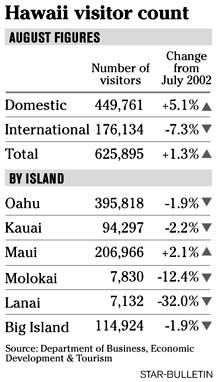
Mainland visitors
boost tourismArrivals from U.S. cities were higher
than in any previous August
August marked the second month in a row of record-setting domestic visitor arrivals, ending a summer tourism season that began on anxiety over world events.
Some 625,895 visitors poured into the islands last month, up 1.3 percent from 617,899 in August 2002, but down 3.1 percent from 645,700 arrivals in August 2001, the month before the terrorist attacks in America.
The average length of visitor trips continued to rise, a trend that has led the state Department of Business Economic, Development and Tourism to predict that overall visitor spending will rise 5.7 percent this year to a record $10.56 billion from nearly $10 billion last year.
In August, growth continued to be fueled by Hawaii's largest market, the U.S. West, from where the number of travelers increased by 3 percent to 277,833 from 269,767 last year.
"We are very pleased to see the steady growth in the domestic visitor market," said Marsha Wienert, Gov. Linda Lingle's tourism liaison.
Improvement was even more pronounced in the U.S. East, with a 10.9 percent year-over-year increase in arrivals to 138,571 from 124,923 in August 2002.
The year before, in August 2001, Hawaii had 127,062 arrivals from the U.S. East, which is seen as a key base of travelers who stay here longer and spend 10 percent more per day than their West Coast counterparts.
Hawaii's arrivals from U.S. cities in August were higher than any previous August in state history. And domestic arrivals represent 73 percent of Hawaii's total arrivals this year.
International arrivals fell 7.3 percent last month.
The Japan market, which took a nose-dive beginning with the war with Iraq, continued to suffer in August, but the numbers have improved from the 30 percent to 40 percent drop in arrivals seen just a few months ago. Last month, Hawaii had 131,531 Japanese visitors, down 10.3 percent from 146,645 visitors in August 2002, and down nearly 29 percent from 184,336 Japanese arrivals in August 2001.
In a negative trend, the Japanese who came here visited fewer islands in August. For the year, the average number of islands visited by the Japanese has declined by 4.9 percent. In other markets, the trend is not so pronounced.
Continued recovery in the Japanese market also will depend on how soon Japanese airlines can restore flights that have been cut.
The state Hawaii Tourism Authority predicts it will take until late spring for Japanese arrivals to start increasing, according to a draft document. About anything will look better compared to the spring of 2003, when Japanese outbound travel was hammered by the war with Iraq and the scare over severe acute respiratory syndrome, or SARS.
Compared with industry demand for air travel, Hawaii was ahead of the game in August. Total miles flown by paying passengers fell 1.9 percent in August, according to the Air Transport Association of America, based in Washington, D.C.
Maui was the only island to see an increase in arrivals, gaining 2.1 percent year-over-year. Oahu and the Big Island, which get a bigger share of Japanese visitors, both marked 1.9 percent drops in visitors. Kauai had a 2.2 percent decrease.
Wienert said the August results got a boost from business travelers, with 30,698 people coming here for meetings, conventions and incentives, up 3.4 percent from 29,691 people last year.
"Contributing to the August growth in MCI visitors was the American Society of Association Executives convention, which brought over 4,000 visitors to the state, and several conventions from Japan," Wienert said.
The percentage of first-time travelers increased slightly, to 35.9 percent of total visitors, compared with 34.3 percent last year. Repeat travelers continue to dominate the market, which has resulted in a rise in arrivals outside Waikiki. The number of travelers who visited only the neighbor islands has risen 9.6 percent this year, while the number of those who visited only Oahu has fallen 6.6 percent.
In July, total visitor spending increased 3.9 percent to $981.7 million from $944.7 million last year, according to the most recent data available from the state. U.S. West visitors spent 4.2 percent more per day than they did last year, $145.70 on average, per person.
Per-day spending fell in all other major markets with a 0.7 decrease in U.S. East spending, which was $157.60 per day, and a 6.1 percent decrease in Japanese spending, which was $220.20 per day.
The state forecasts that Hawaii will have 6.47 million arrivals this year, down nearly 7 percent from the record 6.95 million in 2000. Next year, the state predicts arrivals of 6.87 million, up 6.2 percent.
